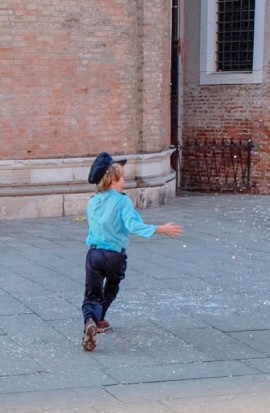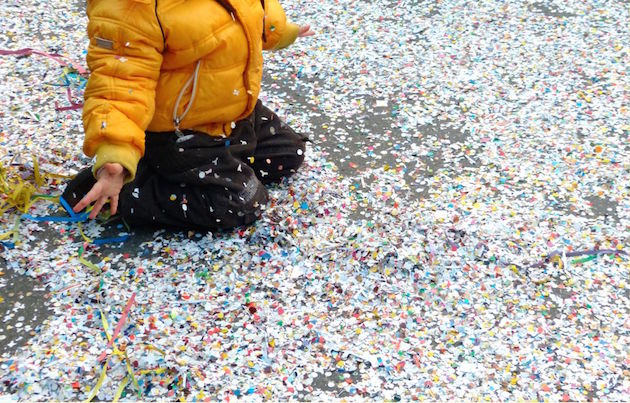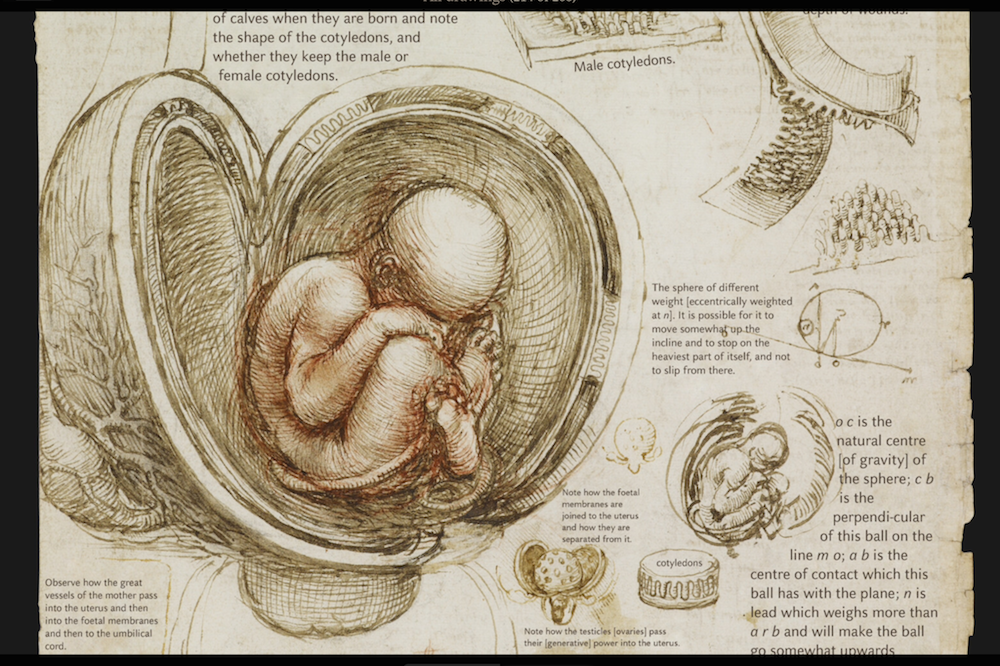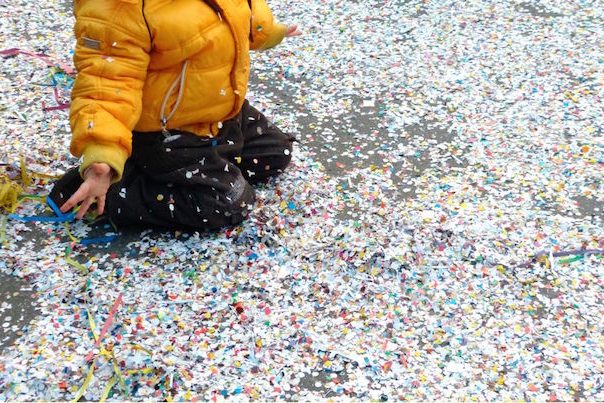Childhood is in the details.
Perhaps this is obvious, I don’t know. But it occurred to me recently that as much as we adults might, in depicting childhood, get caught up in the sweep and swoon and sentiment and swim of it all, in lighting effects and filters and all the rest, the thrills of childhood for the child himself or herself often reside in the most concrete things—whose appeal often eludes full adult comprehension.
The thing that occasioned these thoughts is coriandoli, or confetti.
I don’t think I’m the only adult—or at least not the only American adult—who might be surprised by how important a role this stuff plays in Venetian kids’ sense of Carnevale. Based upon my own seven-year-old son, I’ve been tempted to think at times this year that confetti ranks almost as high as costumes in the festivities for kids.
An adult visiting Venice during Carnevale could easily miss confetti’s centrality completely. Though once your attention is called to it you’ll notice bags of coriandoli displayed for sale in every window of every tabaccheria selling the variety of cheap plastic disguises—fake eyeglasses with bulging eyeballs or a huge nose, over-sized plastic ears—aimed at local kids, not tourists in search of stereotypically “Venetian” masks (even if made in China).
In the weeks leading up to Carnevale Sandro talked much more excitedly about the coriandoli and the neon-colored goopy string-stuff sprayed out of a can than costumes. Of course this is one of the great benefits of living in a place where certain things are rigorously, and by common agreement, limited to certain constricted periods of the year: scarcity and narrow associations greatly enhance their appeal.
I suppose a child could toss handfuls of confetti on Via Garibaldi in December, but he’d generally be considered to be littering by most passing adults, who’d direct a suitably damning look at his parents. (Just as in non-touristy areas of Italy, such as the small Piemonte village we lived outside of for three months, the prohibition against a gelateria/pasticceria beginning to make gelato too early in April—when the weather is “troppo freddo”—has the weight of a moral absolute.)

Perhaps it’s only because confetti played no role at all in my own California childhood that I’ve been so surprised by its importance here. (Would it have been just too hard to clean up in a place with lawns rather than paving stones?) But it seems to have been a central element of Italian Carnevale for a long time.
Indeed, the great American writer Nathaniel Hawthorne explicitly equates the one with the other when he writes about his 1858 experience of Carnevale in Rome (in Passages from the French and Italian Notebooks): “Soon I had my first experience of the Carnival in a handful of confetti, right slap in my face…”
In fact it really does seem in Hawthorne’s account that the throwing of confetti and other supposedly harmless materials is the main point of the Carnevale festivities in Rome. So much so that costumes are valued only so far as they provide protection from assault, like armor at a medieval jousting tournament. And he points out that “wire masks over the face were [worn as] a protection by both sexes—not a needless one, for I received a shot in my right eye which cost me many tears.”
Along with confetti Hawthorne notes that revelers in Rome threw flowers and bouquets (to ladies), sugar-plums, “winged seeds” (blown from a straw), “something that looked more like a cabbage than a flower” (by which Hawthorne was hit on another day) and lime.
Considering this last material is traditionally thrown upon the corpses in mass graves, it seems to be an appropriately morbid harbinger of Ash Wednesday and the Lenten season that Carnevale precedes and prepares for. But throwing it at people during Carnevale was liable to result in a police summons for those who did so, Hawthorne writes.
According to a native Venetian friend of mine, there was a similar problem with the kinds of things being thrown at people during the first couple years after Carnevale’s official re-introduction here in Venice in 1980. It seems in those rowdier first years roving gangs of youths would pelt costumed revelers with flour and rotten eggs. While certainly in keeping with the anarchic origins of carnival, this wasn’t at all appreciated, and by the third year local authorities had cracked down on such aggression.
But aggression, I’ve learned firsthand, remains an elemental part of carnival. Not that you’d know it, fortunately, on any given afternoon these days in Piazza San Marco, when perhaps as many as two dozen elaborately costumed folks (or more) are posing for hoards of happy shutterbugs.
No, you need to happen upon a kids’ celebration of Carnevale in one of the lesser campi, or within the confines of a patronato (parish hall), or on Via Garibaldi, where the coriandoli still flies, and is flung fiercely—as often as merrily—as part of helter-skelter games of chase.
Note how thrilled the kids are to launch volleys of coriandoli at adults—either their own or the parents of others. As masks traditionally subverted the established social hierarchy by concealing identity and one’s “proper” or usual place, so coriandoli still gives kids the chance to upend their usual power relationship with adults, becoming physically aggressive toward them with impunity (for the most part).
And as Carnevale was traditionally a period of excess immediately preceding the sober privations of Lent, so a chief pleasure of coriandoli seems to be the extravagant squandering of it. For any parent in the habit of forecasting how long a given toy is likely to engage a child it comes as quite a shock to find that the large bag of coriandoli you’ve bought for a party—as directed by the invitation—is basically emptied as soon as you’ve opened it.
The cookies or beverages one might usually bring to a kids’ party would have lasted longer!
For before I’d even finished greeting the host of a party last weekend in Campo San Giacomo dall’Orio Sandro was returning the large empty bag to me. “I didn’t even get to see you throw it!” I said to him, imagining, in my naivete, that the whole point of coriandoli was the spectacle of its bright abundant colorful drift through the air, the children capering quaintly beneath it.
But I soon learned two things. First, that a chief pleasure of coriandoli seems to be in the recycling of it. Of gathering up handfuls of it from the paving stones and setting off in pursuit of your target
And, second, that coriandoli, really, is the Carnevale version of those old cream pies in silent films. Each finding its proper comical end in its delivery to some victim’s face or head. Even—or especially!—my own.
In any case, what I’ve come to like about coriandoli is the fact that these days a few stray colored dots of paper turn up absolutely everywhere. I don’t mean the dusting of them in calli or campi—though I like seeing them there, too—but in the more intimate places of one’s life. On the floor of our apartment, or clinging to our furniture. Two or three of them under the covers of our bed. A good dozen of them in one pocket of my coat, a couple more in the other. One in the chest pocket of my shirt, a few more in my bag.
I like how they turn up unexpectedly even after you think you’ve made a good thorough cleaning of your place or person. Dots of pleasant recent memories, bits of experiences. Reminders of small things which, if I’m lucky, I’ll never forget.
For more about living in Venice, visit Steven Varni’s blog: veneziablog.blogspot.com































